|
|
 |
Fiche d'espèce de Copépode |
|
|
Calanoida ( Ordre ) |
|
|
|
Arietelloidea ( Superfamille ) |
|
|
|
Heterorhabdidae ( Famille ) |
|
|
|
Heterorhabdus ( Genre ) |
|
|
| |
Heterorhabdus papilliger Claus, 1863 (F,M) | |
| | | | | | | Syn.: | Heterochaeta papilligera Claus, 1863 (p.182, figs.);
Heterochäta papilligera : Giesbrecht, 1892 (p.372, 382, 773, figs.F,M);
no H. papilliger: Bradford, 1970 a (p.358, figs.F,M); 1972 (p.46, figs.F);
Heterorhabdus (Heterorhabdus) papilliger : Vervoort, 1965 (p.120, Rem.); Bradford-Grieve,1999 b (p.83, figs.F,M, Rem., figs.175, 191) | | | | Ref.: | | | Giesbrecht & Schmeil, 1898 (p.114, Rem. F,M); Thompson & Scott, 1903 (p.235); Esterly, 1905 (p.184, figs.F,M); A. Scott, 1909 (p.131, Rem.); Wolfenden, 1911 (p.302); Pesta, 1920 (p.531); Sars, 1925 (p.229, figs.F,M); Farran, 1926 (p.282); 1929 (p.209, 265); Sewell, 1932 (p.300, fig.F); Rose, 1933 a (p.203, figs.F,M); Jespersen, 1934 (p.107); Farran, 1936 a (p.112); Tanaka, 1937 (p.268, figs. juv.M); Mori, 1937 (1964) (p.73, figs.F,M); Wilson, 1942 a (p.190, fig.M); Lysholm & al., 1945 (p.35); Farran, 1948 e (n°16, p.3, figs.F,M); Brodsky, 1950 (1967) (p.352, figs.F,M); Marques, 1953 (p.118); Chiba & al., 1957 (p.308); 1957 a (p.11); Marques, 1959 (p.216); Grice, 1962 (p.222, figs.F, non M); Paiva, 1963 (p.60, figs.F); Tanaka, 1964 a (p.10); Chen & Zhang, 1965 (p.85, figs.F,M); Grice & Hulsemann, 1965 (p.224, 247: Rem.); Saraswathy, 1966 (1967) (p.80); Owre & Foyo, 1967 (p.78, figs.F,M); Mazza, 1967 (p.195, 202, figs.F,M, juv.); Park, 1968 (p.560, figs.F,M); Corral Estrada, 1970 (p.189, fig.M); Bradford, 1971 a (p.132, 133, Rem.); Bowman, 1971 b (p.40, figs.F,M); Razouls, 1972 (p.95, Annexe: p.77, figs.F); Dawson & Knatz, 1980 (p.5, figs.F,M); Björnberg & al., 1981 (p.650, figs.F,M, Rem.); Gardner & Szabo, 1982 (p.366, figs.F,M); Zheng & al., 1982 (p.57, figs.F); Zheng Zhong & al., 1984 (1989) (p.248, figs.F,M); Roe, 1984 (p.358); Chihara & Murano, 1997 (p.818, Pl.119,120: F,M); Ohtsuka & al., 1997 (p.579, fig.F); Lapernat, 1999 (p.19, fig.F); Bradford-Grieve & al., 1999 (p.883, 944, figs.F,M); Barthélémy, 1999 a (p.8, Fig.18); Park, 2000 (p.106, figs.F,M, Rem.); Conway & al., 2003 (p.88, figs.F,M, Rem.); Mulyadi, 2004 (p.186, figs.F,M, Rem.); Avancini & al., 2006 (p.100, Pl. 69, figs.F,M, Rem.); Vives & Shmeleva, 2007 (p.303, figs.F,M, Rem.) | 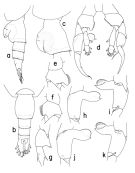 issued from : T. Park in Bull. Scripps Inst. Oceanogr. Univ. California, San Diego, 2000, 31. [p.227, Fig.75]. Female: a, b, urosome (left, dorsal, respectively); c, genital segment (left). Male: d, P5 (anterior); e, basipod of right P5 (anterior); f, basipod of left P5 (anterior); g, exopod of left P5 (anterior); h, i, second exopodal segment of right P5 (anterior, posterior, respectively); j, second exopodal segment of right P5 from different specimen (anterior, posterior, respectively). Nota female: - Prosome 71% length of body and about 2.3 times length of urosome. - Dorsally, genital somite widest at middle, with smoothly bulging, symmetrical lateral margins and typically with a length-width ratio of 100 : 78. Laterally, genital somite only slightly longer than deep, with a low dorsal hump about 3/7 length of somite from anterior end and a more or less rounded genital prominence, which has a nearly straight anterior slope making an angle of about 60° with longitudinal axis of somite and a posterior slope only slightly bulging and extending down to posterior end of somite. - Urosome 31% length of body. First 3 urosomal somites armed with spinules along posterior margins. Length ratios of 4 urosomal somites and left caudal ramus 37.7 : 19.5 : 14.5 : 8.2 : 20.1 = 100. - Left caudal ramus extending beyond posterior end of right ramus by about 1 /6 its length as measured along medial margin. Dorsal appendicular seta of left caudal ramus a little longer than that of right ramus. 4th marginal seta of left ramus much thicker than other marginal setae and longer than body. - Dorsally, anal segment with a pore on each side and each caudal ramus with a pore. - A1 reaching about posterior end of 3rd urosomal somite. - All cephalosomal appendages and swimming legs similar to those of H. guineanensis. Nota male: - Left geniculate A1 similar to that of H. spinifrons. - All other cephalosomal appendages and P1 to P4 as in female. - P5, inner lobe of right basis relatively narrow, slightly shorter than 1/2 length segment, and pointein in a distomedial direction. Inner lobe of left basis low but clearly definable , and distally produced into a short process. In right exopod, medial projection of 2nd segment (fig.75 h, k) with a large, rounded, plumose proximal lobe and without a definable distal lobe; whole distal margin of medial projection smoothly curved and inseparably merged into a relatively large terminal spiniform process (fig.75 i); outer spine of 2nd segment relatively long and arising close to distal end of segment. 3rd segment (fig.75 d) smoothly curved, about as long as combined lengths of first 2 segments; its outer spine small, located distal to midpoint of segment; terminal spine about 1/6 length of segment, and terminal lobe about 2/5 length of terminal spine. In left exopod (fig.75 g), 2nd with a large lateral conical process terminating with small outer spine. Measured along medial margins, outer spine about 2/3 length of conical process. 3rd segment (fig.75 d) tapering distally into a rather bluntly pointed spiniform process, with a small outer and a long inner spine.
|
 issued from : J.M. Bradford-Grieve in The Marine Fauna of New Zealand: Pelagic Calanoid Copepoda. National Institute of Water and Atmospheric Research (NIWA). NIWA Biodiversity Memoir, 111, 1999. [p.83, Fig.50]. Female: A, genital somite (dorsal); B, idem (right lateral side); C, Mx2; D, exopod segment 3 of P5; E, endopod of P5. Mx2: 5th lobe with setae of equal length. Male: F, P5.
|
 Issued from : T.S. Park in Fishery Bull. Fish Wildl. Serv. U.S., 1968, 66 (3). [p.558, Pl.10, figgs.14-21]. Female: 14, habitus (dorsal); 15, idem (lateral left side); 16, forehead (lateral); 17, Mx1; 18, Mx2; 19, P5 (anterior).. Male: 20, habitus (lateral left side); 21, P5 (anterior). Nota: For Park, this species is characterized by the triangularly produced forehead in lateral view and the 3 equal terminal spines of Mx2.
|
 issued from: Q.-c Chen & S.-z. Zhang in Studia Marina Sinica, 1965, 7. [Pl.34,1-6]. Female (from E China Sea): 1, habitus (dorsal); 2, idem (lateral right side); 3, Mxp; 4, right P5 (antrior). Male: 5, habitus (dorsal); 6, P5 (anterior).
|
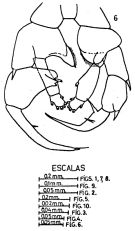 issued from : J. Corral Estrada in Tesis Doct., Univ. Madrid, A-129, Sec. Biologicas, 1970. [Lam.50, fig.6]. Male (from Canarias Is.): 6, P5.
|
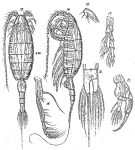 Issued from : G.O. Sars in Résult. Camp. Scient. Prince Albert I, 69, pls.1-127 (1924). [Pl.LXII, figs.3-19]. Female: 13, habitus (dorsal); 14, idem (lateral left side); 15, forehead (lateral); 16, Mxp; 17, P5; 18, anal segment and caudal rami (dorsal). Male: 19, right P5.
|
 Issued from : R.B.S. Sewell in Mem. Indian Mus., 1932, X (continued). [p.299, Fig.97]. Female (from Laccadive Sea): habitus (dorsal).
|
 issued from : Z. Zheng, S. Li, S.J. Li & B. Chen in Marine planktonic copepods in Chinese waters. Shanghai Sc. Techn. Press, 1982 [p.57, Fig.32]. Female: a, habitus (dorsal); b, forehead (lateral); c, urosome (lateral, left side); d, Mx2; e, Mxp; f, P5. Scale bar in mm.
|
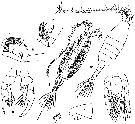 issued from : T. Mori in The pelagic Copepoda from the neighbouring waters of Japan, 1937 (1964). [Pl.37, Figs.7-13]. Female: 7, Mx2; 8, Mxp; 9, habitus (dorsal); 12, head (lateral); 13, P5. Male: 10, habitus (dorsal); 11, P5 (posterior).
|
 issued from : T. Mori in The pelagic Copepoda from the neighbouring waters of Japan, 1937 (1964). [Pl.38, Figs.1-4]. Female: 1, A2; 2, P1; 3, P3; 4, Md (mandibular blade).
|
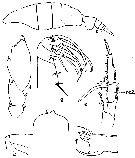 issued from : C.O. Esterly in Univ. Calif. Publs. Zool., 1905, 2 (4). [p.184, Fig.38]. Female (from San Diego Region): a, habitus (lateral); b-c, forehead (lateral and dorsal, respectively); e, P5 (re2 = nd segment of exopodite); g, Mx2. Male: d, exopod of P3; f, right Md (biting edge)
|
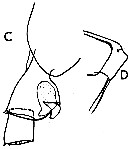 issued from : C. Razouls in Th. Doc. Etat Fac. Sc. Paris VI, 1972, Annexe. [Fig.43, D-C]. Female (from Banyuls, G. of Lion): D, forehead (lateral); C, postrior part of cephalothorax, genital segment and urosomal segment 2 (lateral)
|
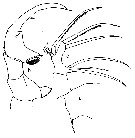 issued from : T.E. Bowman in Smithson. Contr. Zool., 1971, 96. [p.47, Fig.43, a-d]. Male (from Florida): a, forehead (lateral); b, exopod of right P5. Female: c, distal end of Mx2.
|
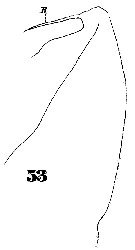 Issued from : W. Giesbrecht in Systematik und Faunistik der Pelagischen Copepoden des Golfes von Neapel und der angrenzenden Meeres-Abschnitte. – Fauna Flora Golf. Neapel, 1892. Atlas von 54 Tafeln. [Taf. 39, Fig. 53]. As Heterochäta papilligera. Female: 53, head (lateral).
|
 Issued from : W. Giesbrecht in Systematik und Faunistik der Pelagischen Copepoden des Golfes von Neapel und der angrenzenden Meeres-Abschnitte. – Fauna Flora Golf. Neapel, 1892. Atlas von 54 Tafeln. [Taf. 39, Fig. 40]. As Heterochäta papilligera. Male: 40, habitus (dorsal).
|
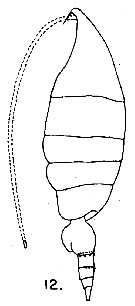 issued from : G.D. Grice in Fish. Bull. Fish and Wildl. Ser., 1962, 61. [p.221, Pl.24, Fig.12]. Female (from equatorial Pacific): 12, habitus (lateral).
|
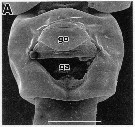 issued from : R.-M. Barthélémy in These Doct. Univ. Provence (Aix-Marseille I), 1999. [Fig.18, A]. Female (Gulf of Marseille: France): A, external ventral view genital double-somite. ga = genital atrium; go = genital operculum (lifted up) Scale bar: 0.100 mm.
|
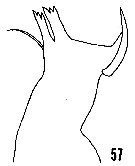 issued from : H.B. Owre & M. Foyo in Fauna Caribaea, 1, Crustacea, 1: Copepoda. Copepods of the Florida Current. 1967. [p.18, Fig.57]. Female: 57, Md (distal part of gnathobase).
|
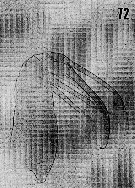 issued from : H.B. Owre & M. Foyo in Fauna Caribaea, 1, Crustacea, 1: Copepoda. Copepods of the Florida Current. 1967. [p.20, Fig.72]. Male: 72, Mx2.
|
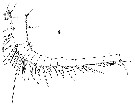 Issued from : W. Giesbrecht in Systematik und Faunistik der Pelagischen Copepoden des Golfes von Neapel und der angrenzenden Meeres-Abschnitte. – Fauna Flora Golf. Neapel, 1892, 19 , Atlas von 54 Tafeln. [Taf.20, Fig.4]. As Heterochäta papilligera. Female: 4, proximal segments of A1 (ventral surface).
|
 Issued from : W. Giesbrecht in Systematik und Faunistik der Pelagischen Copepoden des Golfes von Neapel und der angrenzenden Meeres-Abschnitte. – Fauna Flora Golf. Neapel, 1892, 19 , Atlas von 54 Tafeln. [Taf.20, Fig.8, 15]. As Heterochäta papilligera. Female: 8, Mx1 (posterior surface); 15, Mx2 (posterior surface). L = lobe.
|
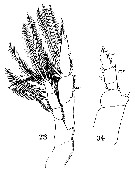 Issued from : W. Giesbrecht in Systematik und Faunistik der Pelagischen Copepoden des Golfes von Neapel und der angrenzenden Meeres-Abschnitte. – Fauna Flora Golf. Neapel, 1892, 19 , Atlas von 54 Tafeln. [Taf.20, Figs.23, 34]. As Heterochäta papilligera. Female: 23, P5 (anterior surface); endopod of P2 (anterior surface). arrow corresponding to the occurrence of one seta.
|
 Issued from : W. Giesbrecht in Systematik und Faunistik der Pelagischen Copepoden des Golfes von Neapel und der angrenzenden Meeres-Abschnitte. – Fauna Flora Golf. Neapel, 1892, 19 , Atlas von 54 Tafeln. [Taf.20, Figs.7, 10]. As Heterochäta papilligera. Male: 7, left Md (mandibular edge); 10, right Md (mandibular edge). Nota: Note the difference between the left and right edge of Md. Same scale for the two Md.
|
 Issued from : W. Giesbrecht in Systematik und Faunistik der Pelagischen Copepoden des Golfes von Neapel und der angrenzenden Meeres-Abschnitte. – Fauna Flora Golf. Neapel, 1892, 19 , Atlas von 54 Tafeln. [Taf.20, Fig.17]. As Heterochäta papilligera. Male: 17, Mxp (anterior view).
|
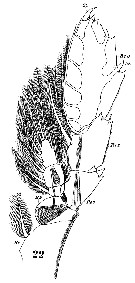 Issued from : W. Giesbrecht in Systematik und Faunistik der Pelagischen Copepoden des Golfes von Neapel und der angrenzenden Meeres-Abschnitte. – Fauna Flora Golf. Neapel, 1892, 19 , Atlas von 54 Tafeln. [Taf.20, Fig.22]. As Heterochäta papilligera. Male: 22, P3 (anterior surface).
|
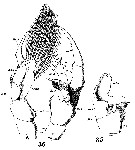 Issued from : W. Giesbrecht in Systematik und Faunistik der Pelagischen Copepoden des Golfes von Neapel und der angrenzenden Meeres-Abschnitte. – Fauna Flora Golf. Neapel, 1892, 19 , Atlas von 54 Tafeln. [Taf.20, Figs.35, 36]. As Heterochäta papilligera. Male: 35, exopodire 1 and 2 of right P5 (posterior view); 36, P5 (anterior view). B2 = basipodite 2 (= Basis); Re = exopod; Ri = endopod; Pd = left leg; Pd = right leg.
|
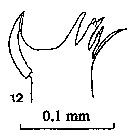 issued from : P.E. Lapernat & C. Razouls in Vie Milieu, 2002, 52 (1). [p.28, Pl. VI, fig.12]. Masticatory edge of right Md gnathobase female (from off Malta, Mediterranean Sea).
|
 issued from : Mulyadi in Published by Res. Center Biol., Indonesia Inst. Sci. Bogor, 2004. [p.186, Fig.106]. Female (from 07°29\\\\\\\\\\\\\\\"S, 121°05'E): a, habitus (dorsal); b, genital complex (lateral right side); c, P5. male: d, habitus (dorsal); e, P5.
|
 Heterorhabdus papilliger Heterorhabdus papilliger female: 1 - See key to species groups of Heterorhabdus: ''papilliger'' Group (p.90, 102). 2 - Midanterior tubercular process of forehead produced into an angular process and not produced into a spiniform process. P5 with inner marginal seta on 1st endopodal segment. 3 - Laterally, genital prominence extending down to posterior end of somite (Fig.75-a). 4 - Laterally, genital prominence more or less rounded, with a moderately sloping anterior wall making an angle of about 60° with longitudinal axis of somite (Fig.75-c). 5 - Laterally, posteroventral margin of genital somite nearly straight and not inflated (Fig.775-c).
|
 Heterorhabdus papilliger Heterorhabdus papilliger male: 1 - See key to species groups of Heterorhabdus: ''papilliger'' Group (p.90, 102). 2 - Medianterior tubercular process of forehead angular and not produced into a spiniform process. Basal inner lobe of left P5 rather poorly developed with feable angular distally (Fig.75-f). 3 - In right P5, medial projection of 2nd exopodal segment terminally expanded, with a large, rounded lobe (Fig.75-h). 4 - In medial projection of 2nd exopodal segment of right P5, distal lobe poorly developed and undifferentiated (Fig.75-k).
|
 issued from : J.M. Bradford in N.Z. Jl mar. freshw. Res., 1971, 5 (1). [p.133, Table 2): Differences between H. lobatus and H. papilliger.
| | | | | Ref. compl.: | | | Cleve, 1904 a (p.191); Rose, 1924 d (p.480); Massuti Alzamora, 1942 (p.95, Rem.); Sewell, 1948 (p.349, 503, 509, 519, 521, 547, 558, 567); C.B. Wilson, 1950 (p.240); Yamazi, 1958 (p.150, Rem.); Gaudy, 1962 (p.93, 99, Rem.: p.111); Duran, 1963 (p.23); V.N. Greze, 1963 a (tabl.2); Shmeleva, 1963 (p.141); Grice, 1963 a (p.496); Gaudy, 1963 (p.26, Rem.); Ahlstrom & Thrailkill, 1963 (p.57, Table 5, abundance); Björnberg, 1963 (p.54, Rem.); Unterüberbacher, 1964 (p.30); De Decker & Mombeck, 1964 (p.12); Shmeleva, 1965 b (p.1350, length-volume-weight relation); Pavlova, 1966 (p.44); Neto & Paiva, 1966 (p.27, Table III); Furuhashi, 1966 a (p.295, vertical distribution in Oyashio/Kuroshio regions, Table 8, 9); Mazza, 1966 (p.71); 1967 (p.367); Ehrhardt, 1967 (p.740, geographic distribution, Rem.); Grice & Hulsemann, 1967 (p.18); Fleminger, 1967 a (tabl.1); Vinogradov, 1968 (1970) (p.78, 268); Dowidar & El-Maghraby, 1970 (p.268); Morris, 1970 (p.2301); Park, 1970 (p.477); Deevey, 1971 (p.224); Roe, 1972 (p.277, tabl.1, tabl.2); Apostolopoulou, 1972 (p.328, 361); Bainbridge, 1972 (p.61, Appendix Table I: vertical distribution vs day/night, Table II: %); Björnberg, 1973 (p.346, 387); Corral Estrada & Pereiro Muñoz, 1974 (tab.I); Vives & al., 1975 (p.49, tab.II, III); Deevey & Brooks, 1977 (p.256, tab.2, Station "S"); Tranter, 1977 (p.596); Carter, 1977 (1978) (p.36); Binet, 1979 (p.400); Dessier, 1979 (p.206); Vaissière & Séguin, 1980 (p.23, tab.1); Vives, 1982 (p.293); Kovalev & Shmeleva, 1982 (p.84); Scotto di Carlo & Ianora, 1983 (p.150); Dessier, 1983 (p.89, Tableau 1, Rem., %); Guangshan & Honglin, 1984 (p.118, tab.); Tremblay & Anderson, 1984 (p.5: Rem.); De Decker, 1984 (p.317, 351: carte); Cummings, 1984 (p.163, Table 2); Scotto di Carlo & al., 1984 (1042); Regner, 1985 (p.11, Rem.: p.36); Brenning, 1985 a (p.28, Table 2); 1986 (p.13, Rem.); Brinton & al., 1986 (p.228, Table 1); Chen Y.-Q., 1986 (p.205, Table 1: abundance %, Table 2: vertical distribution); Madhupratap & Haridas, 1986 (p.105, tab.1); Rudyakov, 1986 (tab.1); Wiebe & al., 1988 (tab.7); Lozano Soldevilla & al., 1988 (p.59); Heinrich, 1990 (p.18); Suarez & al., 1990 (tab.2); Madhupratap & Haridas, 1990 (p.305, fig.3: vertical distribution night/day; fig.7: cluster); Scotto di Carlo & al., 1991 (p.271); Hattori, 1991 (tab.1, Appendix); Shih & Marhue, 1991 (tab.3); Suarez & Gasca, 1991 (tab.2); Hernandez-Trujillo, 1991 (1993) (tab.I); Suarez, 1992 (App.1); Hays & al., 1994 (tab.1); Kouwenberg, 1994 (tab.1); Shih & Young, 1995 (p.70); Kotani & al., 1996 (tab.2); Park & Choi, 1997 (Appendix); Hure & Krsinic, 1998 (p.66, 102); Suarez-Morales, 1998 (p.345, Table 1); Suarez-Morales & Gasca, 1998 a (p.110); Siokou-Frangou, 1999 (p.478); Lopes & al., 1999 (p.215, tab.1); Lapernat, 2000 (tab.3); Razouls & al., 2000 (p.343, Appendix); Fernandez-Alamo & al., 2000 (p.1139, Appendix); Seridji & Hafferssas, 2000 (tab.1); Lopez-Salgado & al., 2000 (tab.1); Madhupratap & al., 2001 (p. 1345, vertical distribution vs. O2, figs.4, 5: clusters, p.1353); d'Elbée, 2001 (tabl. 1); Lapernat & Razouls, 2001 (tab.1); Rebstock, 2001 (tab.2); Holmes, 2001 (p.16); Rebstock, 2002 (p.71, Table 3, Fig.4, climatic variability); Beaugrand & al., 2002 (p.1692); Zerouali & Melhaoui, 2002 (p.91, Tableau I); Beaugrand & al., 2002 (p.179, figs.5, 6); Vukanic, 2003 (139, tab.1); Hsiao & al., 2004 (p.326, tab.1); CPR, 2004 (p.55, fig.158); Fernandez & al., 2004 (p.501, tab.5); Lo & al., 2004 (p.89, tab.1); Zuo & al., 2006 (p.162: tab.1); Isari & al., 2006 (p.241, tab.II); Hwang & al., 2006 (p.943, tabl. I); Dias & Araujo, 2006 (p.50, Rem., chart); Lavaniegos & Jiménez-Pérez, 2006 (p.145, tab.2, 4, Rem.); Hwang & al., 2007 (p.24); Khelifi-Touhami & al., 2007 (p.327, Table 1); Albaina & Irigoien, 2007 (p.435: Tab.1); Valdés & al., 2007 (p.104: tab.1); Dur & al., 2007 (p.197, Table IV); Castro & al., 2007 (p.486, fig.3, Table 1, 2, 3); Jitlang & al., 2008 (p.65, Table 1); Cabal & al., 2008 (289, Table 1); Neumann-Leitao & al., 2008 (p.799: Tab.II, fig.6); Morales-Ramirez & Suarez-Morales, 2008 (p.520); Fernandes, 2008 (p.465, Tabl.2); Lan Y.C. & al., 2008 (p.61, Table 1, % vs stations); Tseng L.-C. & al., 2008 (p.153, Table 2, occurrence vs geographic distribution); Ayon & al., 2008 (p.238, Table 4: Peruvian samples); Pagano, 2009 (p.116); C.-Y. Lee & al., 2009 (p.151, Tab.2); Galbraith, 2009 (pers. comm.); Licandro & Icardi, 2009 (p.17, Table 4); C.E. Morales & al., 2010 (p.158, Table 1); Brugnano & al., 2010 (p.312, Table 3, fig.8); Hafferssas & Seridji, 2010 (p.353, Table 3); Williamson & McGowan, 2010 (p.273, Table 3, Pacific central gyres: N and S); Schnack-Schiel & al., 2010 (p.2064, Table 2: E Atlantic subtropical/tropical)Hidalgo & al., 2010 (p.2089, Table 2); Dias & al., 2010 (p.230, Table 1); Mazzocchi & Di Capua, 2010 (p.425); Medellin-Mora & Navas S., 2010 (p.265, Tab. 2); W.-B. Chang & al., 2010 (p.735, Table 2, abundance); Hsiao S.H. & al., 2011 (p.475, Appendix I); Tseng L.-C. & al., 2011 (p.47, Table 2, occurrences vs mesh sizes); Andersen N.G. & al., 2011 (p.71, Fig.3: abundance); Mazzocchi & al., 2011 (p.1163, fig.6, long-term time-series 1984-2006); Tutasi & al., 2011 (p.791, Table 2, abundance distribution vs La Niña event); Isari & al., 2011 (p.51, Table 2, abundance vs distribution); Mazzocchi & al., 2012 (p.135, annual abundance 1984-2006); Uysal & Shmeleva, 2012 (p.909, Table I); Miloslavic & al., 2012 (p.165, Table 2, transect distribution); Brugnano & al., 2012 (p.207, Table 2, 3); Hidalgo & al., 2012 (p.134, Table 2) ; Belmonte & al., 2013 (p.222, Table 2, abundance vs stations); in CalCOFI regional list (MDO, Nov. 2013; M. Ohman, comm. pers.); Tachibana & al., 2013 (p.545, Table 1, seasonal change 2006-2008); Lidvanov & al., 2013 (p.290, Table 2, % composition); Hwang & al., 2014 (p.43, Appendix A: seasonal abundance); Bonecker & a., 2014 (p.445, Table II: frequency, horizontal & vertical distributions); Zaafa & al., 2014 (p.67, Table I, occurrence): Mazzocchi & al., 2014 (p.64, Table 4, 5, abundance); Fierro Gonzalvez, 2014 (p.1, Tab. 3, 5, occurrence, abundance); Dias & al., 2015 (p.483, Table 2, abundance, biomass, production); Zakaria & al., 2016 (p.1, Table 1); Benedetti & al., 2016 (p.159, Table I, fig.1, functional characters); El Arraj & al., 2017 (p.272, table 2, seasonal composition); Benedetti & al., 2018 (p.1, Fig.2: ecological functional group); Chaouadi & Hafferssas, 2018 (p.913, Table II: occurrence); Belmonte, 2018 (p.273, Table I: Italian zones); Hure M. & al., 2018 (p.1, Table 1: abundance, % composition); Palomares-Garcia & al., 2018 (p.178, Table 1: occurrence); Acha & al., 2020 (p.1, Table 3: occurrence % vs ecoregions). | | | | NZ: | 22 | | |
|
Carte de distribution de Heterorhabdus papilliger par zones géographiques
|
| | | | | | | | | | | | | | |  issued from : H.B. Owre & M. Foyo in Fauna Caribaea, 1, Crustacea, 1: Copepoda. Copepods of the Florida Current. 1967. [p.778, Table 35]. issued from : H.B. Owre & M. Foyo in Fauna Caribaea, 1, Crustacea, 1: Copepoda. Copepods of the Florida Current. 1967. [p.778, Table 35].
Vertical distribution of Heterorhabdus papilliger at the ''40-Mile station'' in the Florida Current (± 25°35'N, 79°27'W).
SL 53: 18 V 1958; SL 55: 21 VII 1958. A: during midday; B;: during midnight. |
 issued from : A.A. Shmeleva in Bull. Inst. Oceanogr., Monaco, 1965, 65 (n°1351). [Table 6: 32 ]. Heterorhabdus papilliger (from South Adriatic). issued from : A.A. Shmeleva in Bull. Inst. Oceanogr., Monaco, 1965, 65 (n°1351). [Table 6: 32 ]. Heterorhabdus papilliger (from South Adriatic).
Dimensions, volume and Weight wet. Means for 50-60 specimens. Volume and weight calculated by geometrical method. Assumed that the specific gravity of the Copepod body is equal to 1, then the volume will correspond to the weight. |
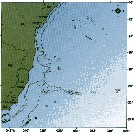 issued from : C. de O. Dias & A.V. Araujo in Atlas Zoopl. reg. central da Zona Econ. exclus. brasileira, S.L. Costa Bonecker (Edit), 2006, Série Livros 21. [p.50]. issued from : C. de O. Dias & A.V. Araujo in Atlas Zoopl. reg. central da Zona Econ. exclus. brasileira, S.L. Costa Bonecker (Edit), 2006, Série Livros 21. [p.50].
Chart of occurrence in Brazilian waters (sampling between 22°-23° S).
Nota: sampling only 1 specimen. |
 Issued from : P.-E. Lapernat in DEA Océanogr. Biol., Univ. P. & M. Curie, Paris VI. July 5, 2000. [Fig.10 d]. Issued from : P.-E. Lapernat in DEA Océanogr. Biol., Univ. P. & M. Curie, Paris VI. July 5, 2000. [Fig.10 d].
Verical distribution of Heterorhabdus papilliger at an oligotrophe site (off NW Cape Verde Islands: 21° N, 31° W) in females (F) and males (M) (ind. per m3) in the day (white circle) and night (black circle).
Nota: Sampling in the water column 0-1000 m, one during the day and another during the night with BIONESS multiple-net: 0-75; 75-150; 150-250; 250-350; 350-450; 450-550; 550-700; 700-850; 850-965 m. In May-June 1992. |
 Issued from : M. Madhupratap & P. Haridas in J. Plankton Res., 12 (2). [p.310, Fig.3]. Issued from : M. Madhupratap & P. Haridas in J. Plankton Res., 12 (2). [p.310, Fig.3].
Vertical distribution of calanoid copepod (mean +1 SE), abundance No/100 m3. 9- Heterorhabdus papilliger.
Night: shaded, day: unshaded.
Samples collected from 6 stations located off Cochin (India), SE Arabian Sea, November 1983, with a Multiple Closing Plankton Net (mesh aperture 300 µm), in vertical hauls at 4 depth intervalls (0-200, 200-400, 400-600, 600-1000 m). |
| | | | Loc: | | | Antarct. (Weddell Sea), sub-Antarct. (SE Pacif.), South Africa (E & W), Namibia, off Tristan da Cunha, off St. Helena Is., off Ascension Is., Angola, Congo, Ghana, G. of Guinea, off Trinidade Is., off Rio de La Plata, S Brazil (off Rio de Janeiro, Campos Basin, off Cabo de Sao Tomé, off Bahia, off Macaé), Cape Verde Is., off NW Cape Verde Is., Morocco-Mauritania, Canary Is., off Madeira, Azores, Ibero-moroccan Bay, Portugal, off Cape Finisterre, Bay of Biscay, off Amazon, Barbada Is., Caribbean Sea, Caribbean Colombia, Jamaica, Yucatan, G. of Mexico, Florida, Sargasso Sea, off Bermuda (Station "S"), Nova Scotia (off Cape Sable), S Strait of Davis, off W Ireland, off SW Ireland, off W Tangier, Medit. (Alboran Sea, Sidi Fredj coast, Gulf of Annaba, Castellon, Banyuls, G. of Lion, Marseille, Monaco, Ligurian Sea, Tyrrhenian Sea, G. of Napoli, Messina, Taranto, off Malta, Adriatic Sea, Ionian Sea, Aegean Sea, Thracian Sea, Lebanon Basin, W Egyptian coast, Alexandria), G. of Aden, Arabian Sea, Madagascar, Natal, Indian, Bay of Bengal, W Australia, Indonesia-Malaysia, Flores Sea, Philippines, China Seas (East China Sea, South China Sea), Taiwan (SW, S, E, Mienhua Canyon, NW), S Korea, Japan, Tokyo Bay, Tanabe Bay, off SE Japan, off Sanriku, Nansei Is., off Hokkaido SE, Bikini, Bering Sea, Aleutian Is., British Columbia, California, W Baja California, Gulf of California, La Paz, G. of Tehuantepec, W Costa Rica, Clipperton Is., Pacif. (W equatorial), Hawaii, Pacif. (equatorial central & subtropical N & S), Pacific (central gyres: N and S), W Colombia, Guaymas Basin, Galapagos-Ecuador, off Peru, Pacif. (SE tropical), off NE Easter Island, Chile (S, off Santiago, Concepcion), Weddell Sea (in Siegel & al.,1992)
Type locality: Mediterranean Sea. | | | | N: | 250 ? | | | | Lg.: | | | (1) F: 2,3; (16) F: 2,03-1,62; M: 1,78; (22) F: 2,2-1,85; M: 2-1,8; (34) F: 1,8-1,72; M: 1,8; (35) F: 1,85; (38) F: 2,34-2,1; M: 2,32-2,22; (46) F: 2,1-1,85; M: 1,9-1,8; (54) M: 2; (72) F: 2,62-1,88; M: 2,65-1,94; (73) F: 2,23-2,14; M: 2,17-2,04; (101) F: 2,14-1,77; ?M: 2,11-1,7; (121) F: 2,04-1,88; M: 1,88; (142) F: 2,2; (199) F: 2,36-1,67; M: 1,98-1,6; (207) F: 2,4-2,04; M: 2,28-1,96; (226) F: 2,3-1,66; M: 2,08-1,64; (237) F: 1,9; M: 1,6-1,7; (290) F: 1,8-2,15; M: 1,8-1,9; (340) F: 1,9; (432) F: 2,55-2,38; (449) F: 2,1-1,85; M: 1,9-1,8; (530) F: 2; M: 1,9; (808) F: 1,82-1,65; (824) F: 2,66-1,66; M: 2,64-1,8; (909) F: 1,8-2,15; M: 1,7-1,9; (991) F: 1,85-2,15; M: 1,7-2; (1023) F: 1,82-1,86; (1122) F: 2,0; M: 1,85; {F: 1,62-2,66; M: 1,60-2,65} | | | | Rem.: | "Papilliger" Group.
épi à bathypélagique, 2000 m (off Malte).
Sampling depth (Antarct., sub-Antarct.) : 0-300 m.
Des confusions existent entre cette espèce et H. lobatus ou H. spinifrons.
Voir aussi les remarques en anglais | | | Dernière mise à jour : 24/10/2022 | |
|
|
 Toute utilisation de ce site pour une publication sera mentionnée avec la référence suivante : Toute utilisation de ce site pour une publication sera mentionnée avec la référence suivante :
Razouls C., Desreumaux N., Kouwenberg J. et de Bovée F., 2005-2025. - Biodiversité des Copépodes planctoniques marins (morphologie, répartition géographique et données biologiques). Sorbonne Université, CNRS. Disponible sur http://copepodes.obs-banyuls.fr [Accédé le 30 novembre 2025] © copyright 2005-2025 Sorbonne Université, CNRS
|
|
 |
 |



































